(2) Health and Medical Care
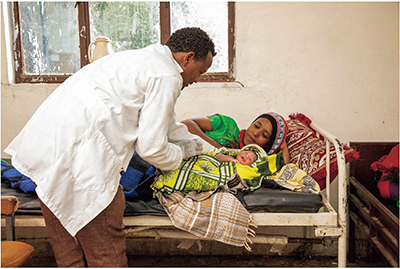
A birth attendant who took part in capacity building training conducted by the United Nations Population Fund (UNFPA) with funding from Japan providing postnatal checkup (Photo: UNFPA)
SDG 3 aims to “Ensure healthy lives and promote well-being for all at all ages.” In addition, achieving universal health coverage (UHC)Note 60 is positioned as an important global target in order to respond to various health issues, diversified across countries and regions. On the other hand, at present, it is estimated that at least half of the world’s population has no access to basic medical care, and that over 5 millionNote 61 children under the age of five die annually due to preventable diseases. Approximately 287,000 womenNote 62 die during and following pregnancy and childbirth per year, primarily due to the lack of emergency obstetric care provided by obstetricians, gynecologists, and/or midwives. Moreover, COVID-19 has had a wide range of effects on everyone on earth. It has also exposed various vulnerabilities, including those related to vaccine distribution, in the current global health architecture (GHA), which comprises the governance and finance for addressing global health and medical issues.
In light of various changes in the global situation, such as the spread of COVID-19, the Government of Japan formulated the “Global Health Strategy” in May 2022. The goal of the Strategy is (i) to contribute to developing GHA for international health security and strengthening Prevention, Preparedness, and Response (PPR) for public health emergencies including pandemics, and (ii) to achieve more resilient, equitable, and sustainable UHC required for the post-COVID-19 era in order to embody human security. Japan promotes initiatives based on this Strategy.
● Japan’s Efforts
■ Building a Global Health Architecture (GHA) that Contributes to Prevention, Preparedness and Response (PPR) to Future Health Crises
Based on the experience and lessons learned from the COVID-19 response, the international community’s interest in strengthening PPR for future health crises is higher than ever.
Japan has provided financial contributions to the World Health Organization (WHO)’s Health Emergencies Programme,Glossary the Contingency Fund for Emergencies (CFE),Glossary and other relevant programmes to support WHO’s response to health crises. These contributions were also used to respond to the acute phase of COVID-19. In addition, Japan announced a cumulative contribution of 70 million US dollars as a founding financial member to the Pandemic Fund, which was established in 2022 and is hosted by the World Bank. Japan also provides assistance for strengthening capacities in preparedness and responses against infectious diseases in developing countries, through an additional contribution to the Health Emergency Preparedness and Response Multi-Donor Trust Fund (HEPRTF), which Japan launched in cooperation with the World Bank Group.
In 2023, Japan, as the G7 Presidency, made a significant contribution to strengthening PPR. As an outcome of the discussions at the G7 Joint Finance and Health Ministers’ Meeting held in May, the Meeting compiled the “G7 Shared Understanding on Enhanced Finance-Health Coordination and PPR Financing,” and in light of the experience with the COVID-19 pandemic, reaffirmed the need to further enhance coordination between finance and health authorities. In addition, the G7 agreed to work with the G20 and others to consider a framework for “surge financing” that would quickly and efficiently provide funds necessary for responding to pandemic outbreaks.
At the G7 Hiroshima Summit that followed in the same month, the G7 leaders committed to enhancing political momentum toward leadership-level governance and strengthening international norms and regulations. In addition, in order to improve equitable access to medical countermeasures (MCMs) including vaccines worldwide, the G7 leaders announced the “G7 Hiroshima Vision for Equitable Access to Medical Countermeasures,” and launched the “MCM Delivery Partnership for Equitable Access (MCDP),” to promote related initiatives. They also endorsed the “Impact Investment Initiative (Triple I) for Global Health,” which aims to mobilize private financial resources through impact investment to solve health issues.
In September, Prime Minister Kishida attended the “G7 Health Follow-up Side Event” held on the occasion of the UN General Assembly. At the event, Prime Minister Kishida mentioned that to ensure smooth financing it is necessary to expand the mobilization of domestic financial resources in each country and accelerate international cooperation and mobilization of private financial resources. He also announced the launch of Japan’s new yen loan program, which, in tandem with technical cooperation, would provide increased support for borrower countries aligned with their efforts to strengthen prevention and preparedness, and will promptly supply financial resources necessary to respond to a pandemic. Furthermore, to facilitate private financing, Prime Minister Kishida announced the launch of the Triple I, which was endorsed at the G7 Hiroshima Summit, and called for further participation in the Triple I initiative by companies and organizations in each country.
Japan also actively contributes to rulemaking in the international arena. In February 2022, under WHO, the first meeting of the Intergovernmental Negotiating Body (INB) on a “WHO convention, agreement or other international instrument on pandemic prevention, preparedness and response (PPR) (WHO CA+)” (the so-called “Pandemic Agreement”) was held, and negotiations are ongoing as of the end of 2023. One Japanese delegate was elected as a vice-chair of the INB, and Japan contributes to the progress of the negotiations as a member state. Japan also actively contributes to the discussions on the amendments to the International Health Regulations (2005) (IHR),Note 63 which are taking place concurrently.
■ Promotion of Universal Health Coverage (UHC)
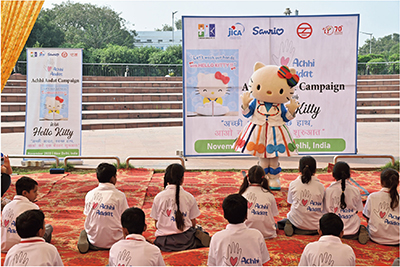
As part of the “Achhi Aadat (good habits) Campaign” run by the JICA India Office, the sponsoring company Sanrio and one of its characters, Hello Kitty, visiting India for the first time to teach children the appropriate handwashing and nail cleaning techniques (Photo: JICA)
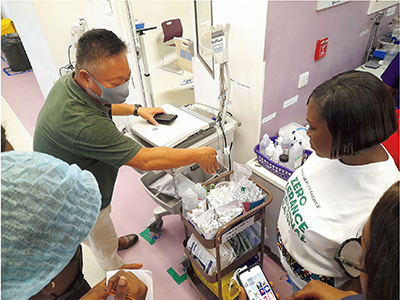
A JICA expert providing guidance at a hospital where trainees receive training under the “Quality of Care for Maternal and Newborn Health with focus on 5S-KAIZEN-TQM” in Ghana (Photo: JICA)
Japan has promoted international cooperation based on the recognition that it is necessary to address existing health issues that suffered a setback since the spread of COVID-19 and to achieve more resilient, equitable, and sustainable UHC.
Japan has heretofore provided support for the health and medical care systems in countries in Southeast Asia and Africa based on the view that building a sustainable and resilient health system will serve as the foundation for controlling infectious diseases. In addition, based on various lessons learned from pandemics such as COVID-19, Japan works to strengthen health systems including the development and networking of core medical facilities and support for human resources development in the medical field. For example, in August 2023, Japan and Madagascar exchanged notes regarding Japan’s support for the improvement of medical equipment in regional referral hospitals in Madagascar through grant aid, with the aim of strengthening diagnostic and treatment systems and improving access to medical services. These efforts contribute to the promotion of UHC, as well as to the PPR for public health emergencies. Japan also provides assistance in a wider range of areas to create a more resilient environment against infectious diseases, including the development of water and sanitation infrastructure such as water supply and sewage systems, and the enhancement of food security. Japan contributes to the prevention of infectious diseases in over 15 countries by providing water purification chemicals, fuel for water trucks, personal protective equipment (PPE) for water utility personnel, and plumbing materials, as well as encouraging handwashing and conducting awareness-raising activities. JICA takes the lead in providing support for environmental improvements through supplying safe and secure water, handwashing facilities, and soaps, as well as in implementing initiatives such as the “Handwashing for Health and Life Campaign” to promote proper handwashing in developing countries (see Part III, 3 (3) on Efforts in the area of water and sanitation).
Primary healthcare services under UHC include all services ranging from nutritional improvement, vaccination, maternal and child health, sexual and reproductive health, infectious disease control, noncommunicable disease (NCD) control, and comprehensive community care and long-term care for older persons (see Part III, Section 1 (1) regarding nutritional improvement).
Especially with regard to maternal and child health in developing countries, there are major issues still unsolved. In response to this situation, in 2023, Japan provided support in many countries including Bangladesh, Burundi, Cambodia, Côte d’Ivoire, Ghana, Laos, Pakistan, and Senegal to improve maternal and child health.
Japan carries out activities utilizing the Maternal and Child Health (MCH) Handbook as a means of improving maternal and child health, drawing on its experience and expertise. The MCH Handbook can contribute to the Continuum of Care (CoC) from pregnancy, childbirth, the post-partum period,Note 64 the neonatal period, infancy, to early childhood. It also enables mothers to acquire knowledge about health, raising their awareness and helping them modify their behavior. As a concrete example of this assistance, in Indonesia the MCH Handbook is widely used throughout the country as a result of Japan’s cooperation. Moreover, in cooperation with JICA, Indonesia’s relevant ministries and agencies hold events to share their experiences and knowledge with other countries that are promoting the use of the MCH Handbook. In 2023, participants from eight countries, Cambodia, Kenya, Laos, Madagascar, Tajikistan, Thailand, Timor-Leste, and Viet Nam, together with Indonesia, learned from each other’s experiences across the nine countries.
In the African region, the “Tunis Declaration,” which was adopted at TICAD 8 in August 2022 as its outcome document, confirms the importance of realizing the concept of human security, building a resilient and sustainable society to achieve the SDGs, and intensifying efforts in the health sector to achieve UHC.
Japanese NGOs work in the area of health and medical care using the Grant Assistance for Japanese NGO Projects scheme. For example, in 2023, Chikyu-no-Stage (English name: Frontline), a Japanese NGO, is conducting the “Improving Reproductive, Maternal, Newborn, and Child Health (RMNCH) in Ermera Municipality” project in Timor-Leste. The project involves introducing compact ultrasound diagnostic equipment and providing training on how to operate it, holding mothers’ classes for pregnant women and nursing mothers, and conducting awareness campaigns using educational materials on maternal and child health.
Japan works in cooperation with international organizations, such as the United Nations Population Fund (UNFPA), the International Planned Parenthood Federation (IPPF), and the World Bank, to promote maternal and child health that includes sexual and reproductive health services, aiming to thereby improve the health of a greater number of women and children. Japan also contributes to raising vaccination rates in developing countries through Gavi, the Vaccine Alliance,Glossary and bilateral cooperation (see also “Japanese Personnel at International Organizations Playing Active Roles on the Front Lines across the World” for the active role played by Japanese UNFPA personnel).
The Asian Development Bank (ADB) positions health as one of the key priority sectors in its “Strategy 2030” and sets the following three pillars to achieve UHC in the Asia-Pacific region in cooperation with Japan: (i) building institutional framework, (ii) accelerating human resources development, and (iii) investing in infrastructures. In April 2021, Japan began contributing to the ADB’s Japan Trust Fund for the purpose of providing technical assistance and small grants to accelerate supports based on these three pillars. As of the end of October 2023, Japan has contributed a total of approximately 11.5 million US dollars through the Fund.
In May 2023, the G7 Health Ministers’ Meeting in Nagasaki, chaired by then Minister of Health, Labour and Welfare Kato, adopted the “G7 Global Plan for UHC Action Agenda,” which outlines further actions that the G7 countries should take to achieve UHC worldwide under the theme of “Working together for a healthier future.” At the G7 Hiroshima Summit, the G7 leaders announced their financial contributions totaling more than 48 billion US dollars from the public and private sectors, with a view to supporting the achievement of UHC in the post-COVID-19 era. As a part of the G7’s contributions, Prime Minister Kishida expressed Japan’s intention to make contributions totaling more than 7.5 billion US dollars from the public and private sectors, including a 200 million US dollars pledge for the Global Health Innovative Technology (GHIT) Fund. In September, Prime Minister Kishida attended the UN General Assembly High-Level Meeting on UHC, where he stated that before the lessons learned from the COVID-19 pandemic are forgotten, the international community needs to, once again, remember and act on the goal of achieving UHC. He also stated that, at the G7 Hiroshima Summit as well, the leaders committed to achieving more resilient, equitable, and sustainable UHC through strengthening health systems. On this basis, Prime Minister Kishida expressed further determination to achieve UHC by 2030.
Japan has supported building health and medical systems in developing countries for many years from various perspectives such as supporting the capacity building of healthcare workers, networking regional hospitals, and strengthening regional health systems. During the COVID-19 crisis, the medical facilities that Japan has supported evidently played central roles for infection control measures. In 2023, Prime Minister Kishida received the Global Goalkeeper Award in recognition of Japan’s leadership focused on health at the G7 Hiroshima Summit and years of immense contribution to global health, demonstrating high recognition from the international community.
■ Efforts on Individual Global Health Issues
(Support in Response to COVID-19)
In response to COVID-19, since its outbreak, Japan has provided a total of approximately 5 billion US dollars in assistance to developing countries through bilateral channels and through international organizations to date. In addition, in order to underpin economic and social activities in developing countries, as well as to address their financial needs, including in the health and medical sectors, Japan has established the COVID-19 Crisis Response Emergency Support Loan and has provided loans totaling 684.8 billion yen to 23 countries from July 2020 to the end of September 2023.
In order to contain COVID-19, it is important to ensure equitable access to safe, effective, and quality-assured vaccines, as well as to therapeutics and diagnostics. Based on this idea, Japan has provided vaccine-related assistance to various countries and regions, in line with international frameworks such as the COVAX Facility (COVID-19 Vaccine Global Access Facility).Glossary As part of the “Last One MileNote 65 Support” to realize the delivery of vaccines to vaccination sites, Japan contributed to improving the cold chainNote 66 system and strengthening healthcare providers’ vaccine administration capacity.
(The Three Major Infectious Diseases (HIV/AIDS, Tuberculosis, and Malaria)
SDG target 3.3 sets out to end epidemics of the three major infectious diseases by 2030. Japan makes strong efforts to support measures against them and strengthen health systems through the Global Fund.Note 67 From its establishment to February 2023, Japan has contributed approximately 4.3 billion US dollars to the Global Fund. Furthermore, at TICAD 8 held in August 2022 and the Global Fund’s Seventh Replenishment Conference in the following month, Prime Minister Kishida announced that Japan would additionally contribute up to 1.08 billion US dollars over the next three years. In order to ensure that measures against the three major infectious diseases are carried out more effectively, Japan also implements bilateral cooperation such as enhancing health systems, community empowerment, and improving maternal and child health as a complementary support to the efforts made through the Global Fund.
As for bilateral cooperation in HIV/AIDS countermeasures, Japan provides assistance to raise awareness for preventing new infections as well as to promote testing and counseling. Primarily in Africa, in 2023, Japan Overseas Cooperation Volunteers (JOCVs) continued to engage vigorously in deepening people’s knowledge and understanding of HIV/AIDS prevention and providing care and support to people living with HIV/AIDS.
With regard to tuberculosis, Japan engages in reducing the annual number of deaths from tuberculosis in developing countries, particularly in Asia and Africa, in accordance with the “Stop TB Japan Action Plan,” revised in 2021. As an interim goal by 2025, Japan aims to achieve a 75% reduction in deaths from tuberculosis (compared to 2015) and a 50% reduction in tuberculosis incidence (compared to 2015; less than 55 cases per 100,000 people) through a public-private partnership, drawing on Japan’s own experience and technology cultivated through its struggle against tuberculosis.
In respect of malaria, one of the major causes of infant mortality, Japan supports the effort to strengthen local communities in Myanmar and Solomon Islands as antimalaria countermeasures. Through contributions to the Global Fund, Japan also takes measures against malaria on a worldwide level.
(Responding to Antimicrobial Resistance (AMR))
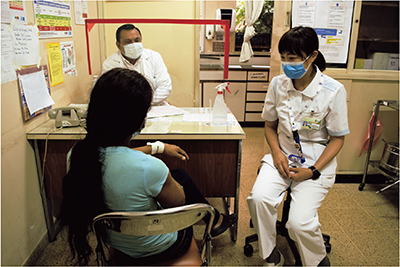
A JOCV providing medical care at the “Hospital Universitario Japones (Japanese University Hospital)” in Santa Cruz, Bolivia (Photo: JICA)
Antimicrobial Resistance (AMR)Note 68 is a serious threat to public health, and in recent years, countermeasures against AMR have gained momentum. In order to advance measures against AMR, Japan promotes the “One Health Approach,” which aims to link, across sectors, those engaged in the field of sanitation concerning humans, animals, and the environment. Based on the agreement at the G20 Osaka Summit in 2019 on promoting the One Health Approach, Japan announced that it would contribute approximately 1 billion yen to GARDP,Note 69 which promotes research and development for new antibiotics and diagnosis development. Japan takes the lead in tackling AMR, including through participation in the Global Leaders Group on Antimicrobial Resistance. In 2023, Japan contributed approximately 250 million yen to GARDP.
(Neglected Tropical Diseases (NTDs))
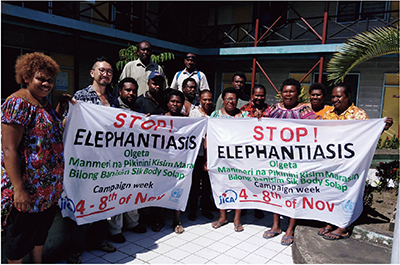
State health officials at the completion of a training session (Papua New Guinea) under the “Project for Elimination of Lymphatic Filariasis in the Pacific Region,” technical cooperation currently being implemented in six Pacific Island countries (Photo: JICA)
Parasitic and bacterial infections, such as Chagas disease, Filariasis, and Schistosomiasis, are known as “neglected tropical diseases (NTDs).” More than 1 billion people worldwide are infected with NTDs, causing major socio-economic losses to developing countries. Japan contributed a total of 18.6 billion yen to the Global Health Innovative Technology (GHIT) Fund by 2023 and provided support for countermeasures against NTDs through GHIT. In addition, Japan signed “the Kigali Declaration on neglected tropical diseases (NTDs)” in June 2022, and cooperates closely with the relevant countries and international organizations on countermeasures against NTDs. At the G7 Hiroshima Summit, Prime Minister Kishida announced a 200 million US dollars pledge for the GHIT Fund.
Japan has provided support against Lymphatic Filariasis for Pacific Island countries through technical cooperation since the 1970s. The “Project for Elimination of Lymphatic Filariasis in the Pacific Region” supports mass drug administration of anthelmintics to stop transmissions in infected areas via public-private partnership, dispatching Japanese experts to provide technical instructions, and utilizing drugs provided to WHO free of charge by the Japanese pharmaceutical company Eisai Co., Ltd. This long-term support from Japan has been proved to be successful, with 9 of 14 Pacific Island countries (Cook Islands, Kiribati, Marshall Islands, Nauru, Niue, Palau, Solomon Islands, Tonga, and Vanuatu) having eliminated Lymphatic Filariasis. Through the dispatch of experts and other means, Japan will continue to support the elimination of Lymphatic Filariasis in Pacific Island countries.
(Polio)
Polio is on the brink of eradication. Japan, in cooperation mainly with UNICEF and Gavi, provides support toward its eradication with a focus on countries where cases of infection are still being identified (polio-endemic countries: Afghanistan and Pakistan). During 2023, in Afghanistan, Japan provided support for routine immunization activities and the procurement of vaccines necessary for polio vaccination campaigns in cooperation with UNICEF. Similar supports are also ongoing in Pakistan.
Featured Project 3
Federated States of Micronesia, Fiji, Kiribati, Marshall Islands, and Palau
Toward Establishing a Safe and Efficient Immunization System
—Strengthening Prevention, Preparedness, and Response (PPR) for Pandemics—
Project for Strengthening Immunization Programs in Pacific Island Countries (Partnership with UNICEF and WHO)
Grant Aid (April 2021 – March 2025)
Pacific Island countries are geographically dispersed and thus face unique challenges and vulnerabilities. Taking the Marshall Islands as an example, the country consists of atolls scattered over an area of approximately 2 million square kilometers of sea, and accessibility within the country and to the outside of the country is poor. In addition, given the vulnerability of the health and medical systems, there is a need to strengthen the immunization services in preparation for the possible influx of various infectious diseases.
Concerning such a situation, Japan, in collaboration with the United Nations Children’s Fund (UNICEF) and the World Health Organization (WHO), provided assistance to the Marshall Islands and four other countries in the Pacific Island countries region (Federated States of Micronesia, Fiji, Kiribati, and Palau) that face similar challenges. It included the provision of equipment to strengthen the cold chain,Note 1 such as Solar Direct Drive (SDD) Refrigerators that can be used even in rural atolls without electricity, as well as boats for transportation among atolls. Japan also provides technical assistance for the maintenance of equipment in collaboration with UNICEF, as well as technical assistance for formulating immunization schedules and strengthening surveillance systems for various infectious diseases in collaboration with WHO.
In the Marshall Islands, community transmission of COVID-19 was first detected in August 2022, and approximately 40% of the population was infected. However, with the equipment provided through the cooperation, timely vaccinations made it possible to contain the situation within approximately one month. Many people in the Marshall Islands expressed their gratitude for Japan’s assistance. The number of people vaccinated against other infectious diseases in rural atolls since August 2022 accounts for as high as 3,000 people in 35 local communities.
Japan will continue to support the strengthening of health systems, including prevention of infectious diseases, in the Pacific Island countries region, to achieve even more resilient, equitable, and sustainable universal health coverage (UHC).

Handover ceremony of Solar Direct Drive (SDD) Refrigerators that can be used even in rural atolls without electricity (Photo: UNICEF)
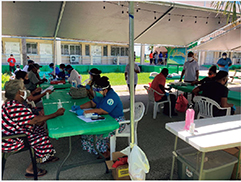
Health screening at a temporary health facility in the Majuro Atoll, Marshal Islands, during the outbreak of community transmission of COVID-19
Note 1: See Note 66.
Glossary
- WHO Health Emergencies Programme
- A part of WHO that responds to health emergencies. It evaluates the health emergency response capacity of countries, supports drafting of plans, and monitors new and ongoing health emergency situations. It also provides health services to save lives in countries where health emergencies are occurring.
- Contingency Fund for Emergencies (CFE)
- An emergency fund for responding to outbreaks and states of emergency established by WHO in 2015 based on its reflection concerning the Ebola virus outbreak in West Africa in 2014. Decision-making regarding contributions is entrusted to the WHO Director-General, and it is possible to provide funding within 24 hours of the decision being made.
- Gavi, the Vaccine Alliance
- A public-private partnership established in 2000 with the aim of saving children’s lives and protecting people’s health by improving immunization coverage in developing countries. Governments of both donor countries and developing countries, relevant international organizations, the pharmaceutical industry, private foundations, and civil society participate in this partnership. Since its establishment, it is said to have vaccinated more than 1 billion children and saved over 16.2 million lives.
- COVAX Facility (COVID-19 Vaccine Global Access Facility)
- A comprehensive mechanism for resource mobilization and supply coordination led by Gavi to secure equitable access to vaccines. COVAX enables the supply of COVID-19 vaccines swiftly at an affordable price, leveraging economies of scale through guaranteeing purchase and market demand for vaccines. The COVAX Facility has provided 2 billion doses of vaccines to 146 countries and regions as of October 2023.
- Note 60: The concept that all people have access to effective and quality-assured health services at affordable costs without financial hardship.
- Note 61: According to the United Nations Children’s Fund (UNICEF) survey (as of 2021).
- Note 62: According to the World Health Organization (WHO) survey (as of 2020).
- Note 63: International Health Regulations (2005) (IHR): Health regulations established by the World Health Organization (WHO) with the aim of preventing the international spread of diseases to the greatest extent possible.
- Note 64: The period after childbirth in which women recover to a similar condition before pregnancy, usually around one to two months after birth.
- Note 65: In fields such as logistics and communication services, this means the last segment of delivery of goods or services between the final provision site and the users or consumers.
- Note 66: A mechanism to deliver products to their destination while maintaining low temperatures. This allows the quality of medical goods such as vaccines to be preserved.
- Note 67: Public-Private Partnership established in 2002, led by the discussion held at the G8 Kyushu-Okinawa Summit in 2000 when infectious diseases control was set as a major discussion topic for the first time. It contributes to efforts to achieve the SDGs by providing financial cooperation for measures against the three major infectious diseases (HIV/AIDS, tuberculosis, and malaria) and strengthening health systems in developing countries.
- Note 68: Pathogenic microorganisms, including bacteria and viruses, gaining resistance to antimicrobials such as antibiotics and antiviral drugs, which causes the drugs to lose sufficient efficacy.
- Note 69: GARDP is an abbreviation for Global Antibiotic Research & Development Partnership.
